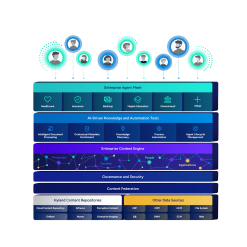What is invoice capture?
Invoice capture provides better, faster visibility into spending patterns and helps organizations make informed decisions about their purchasing and payment processes.

Harness the power of a unified content, process and application intelligence platform to unlock the value of enterprise content.
Learn more
Automate your document-centric processes with AI-powered document capture, separation, classification, extraction and enrichment.
Learn about Hyland IDPIt's your unique digital evolution … but you don't have to face it alone. We understand the landscape of your industry and the unique needs of the people you serve.
 Overview of industries
Overview of industries
Countless teams and departments have transformed the way they work in accounting, HR, legal and more with Hyland solutions.
 Overview of departments
Overview of departments
We are committed to helping you maximize your technology investment so you can best serve your customers.
 Overview of services
Overview of services

Discover why Hyland is trusted by thousands of organizations worldwide.
Hear from our customers
Our exclusive partner programs combine our strengths with yours to create better experiences through content services.
Overview of partners
Join The Shift newsletter for the latest strategies and expert tips from industry leaders. Discover actionable steps to stay innovative.
Register now
Hyland connects your content and systems so you can forge stronger connections with the people who matter most.
Learn about HylandWith our modern, open and cloud-native platforms, you can build strong connections and keep evolving.
 Dig deeper
Dig deeper
Reading time minutes
Invoice capture provides better, faster visibility into spending patterns and helps organizations make informed decisions about their purchasing and payment processes.

Invoice capture is the process of extracting data from invoices — whether in paper or digital formats — and is the first step in invoice processing for accounts payable (AP) departments. Traditionally, organizations use optical character recognition (OCR) software to scan an invoice and turn it into data that can be used with other applications and enterprise resource planning (ERP) solutions.
With the increased adoption of artificial intelligence and machine learning however, AP departments can expect that invoice processing will evolve by becoming more automated and intelligent.
Related articles:
For most AP departments, half of all invoices arrive in paper form while the other half arrive via email or electronic data interchange (EDI). Processing these invoices takes a lot of manual data entry, which could lead to miss-keyed data, lost invoices and lack of visibility into the process.
An invoice capture software, on the other hand, automates the classification, extraction and validation of data from any type of invoice. Invoice capture software helps to:
> Read more | Accounts payable automation: Real-world success stories
Invoice capture is just one of the steps in the procure-to-pay lifecycle. To achieve end-to-end invoice processing automation, you need visibility, control and efficiency over the entire process.
Hyland offers an AP automation solution with intelligent invoice capture, workflow automation and seamless integration with your ERP system.
With an automated invoice processing solution in place, your AP department can transform from being purely administrative to a more strategic role.